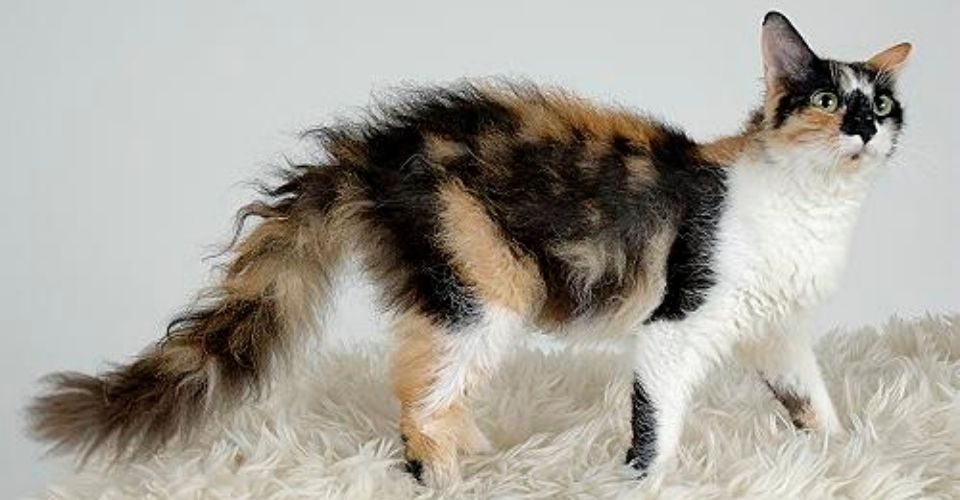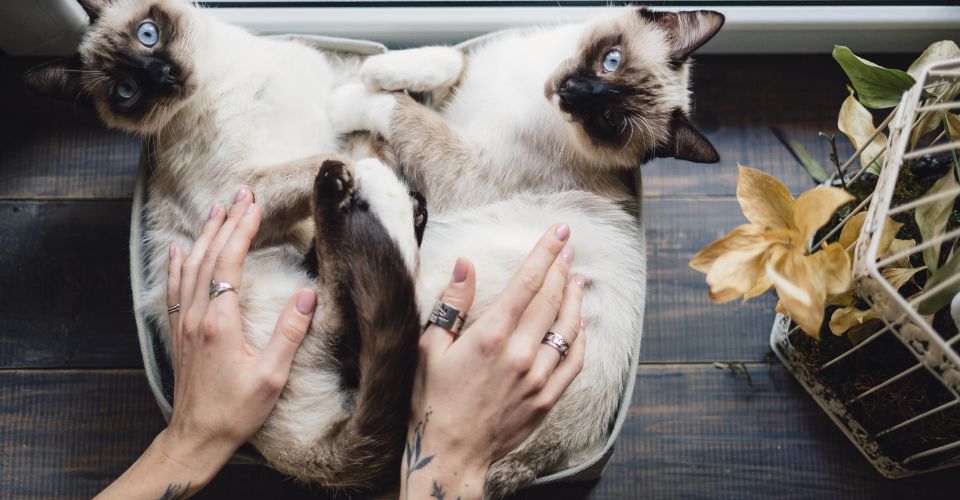Looking at a LaPerm, you might think that this kitty had an electric shock that gave her a curly appearance. But the reality of their curly coat, eyebrows, and whiskers lies in genetic mutation.
Interacting with a LaPerm cat, you will find her to be very friendly and worthwhile as a pet. Despite what they look like, they do not shed much! Plus, they have some canine-like qualities as well… OK, enough spoilers. Now let us jump into the blog.
Did You Know?
The LaPerm breed derives its name from perm hairstyle, which consists of permanent curls set into hair.
LaPerm Overview
LaPerm Overview
Size: 6 to 10 inches
Weight: 8 to 10 pounds
Lifespan: 10 to 15 years
Place of Origin: Oregon, United States
Eye Color: Many including copper, yellow, gold, blue, or aqua
Coat Colors: Every recognized coat color and patterns
Temperament: Sociable, affectionate, lap cat, inquisitive
Suitable For: Families with children, families with other pets
|
Adaptability: |
|
Energy: |
|
|
Intelligence: |
|
Amount of Shedding: |
|
|
Kid-Friendly: |
|
Pet Friendly: |
|
History
Where the history of the Selkirk Rex cat breed began at a shelter in Montana, that of LaPerm cat breed began at a farm located in Oregon. The history of LaPerm kitties began in 1982, when Speedy, a gray tabby barn cat owned by Linda and Richard Koehl, gave birth to a kitten of unusual appearance. To elaborate, unlike her siblings, she was bald, and her ears were big and widely spaced. Besides, her coat hair that eventually grew was wavy. Based on this particular trait, she was dubbed ‘Curly.’
Curly gave birth to five kittens, and all of them bore the same features. Observing this, Linda believed that she might have a new curly-haired cat breed at hand. She further found out that a gene causing curls in the coat was dominant in both males and females. Afterward, she managed to introduce her kitties to a cat show sponsored by the Cat Fanciers’ Association (CFA) in 1992. Receiving an astounding response, Linda then took steps to make her felines recognized by various cat organizations.

Though Curly herself disappeared, Linda’s endeavors in getting Curly’s progeny registered as a separate breed bore fruit. The International Cat Organization (TICA) accepted the breed in 2003. Later on, more organizations followed suit even beyond the United Stated. Today most cat organizations, including the CFA, have recognized LaPerm as a separate cat breed.
Appearance
The cynosure in LaPerm’s appearance is their curly coat. The curls are comparatively relaxed on the body but tighter near the stomach, neck, and ears. Furthermore, the coat is double, mixed-textured, and comes in both short and long types. LaPerms come in all recognized coat colors—including brown, orange, grey, etc.—and color patterns such as calico, tabby, tortoiseshell, etc.
LaPerms are medium-sized cats with medium to large ears, expressive eyes—normally almond-shaped but rounder when alert—broad muzzle with round whisker pads and a slightly dipped nose. Their hips are slightly higher than the shoulders at the hind end as their hind legs are comparatively longer. They have round pads and a tapered tail.

Personality and Temperament
A typical LaPerm personality is inquisitive, clever, friendly, and humorous with lap cat tendencies.
To delve into the details, being inquisitive, LaPerms have a penchant for occupying heights, and that is why you might often find yours on your shoulders. Being clever, LaPerm kitties are known to make talented uses of their paws, such as opening doors. They are friendly and easily socialize with guests and other pets. They tend to be clownish and mischievous at times with a sense of humor.
In addition to the typical traits, these balls of fluff are very active as well. They love to retrieve thrown items and snuggle in the lap of their owners whenever possible. Another somewhat desirable attribute is that they are very quiet, and people rarely hear their voices.
They are, overall, very affectionate and always try to nudge their head against their lovely hoomans, but, simultaneously, they are deadly for the mice: owing to their barn cat ancestry, they have a high prey drive which makes them great mousers.
Tip!
LaPerm cats do not like to spend time alone. Hence, make sure to give your pet enough company.

LaPerm Care
Caring for these kitties is not exacting. As a matter of fact, they make a great choice for inexperienced owners as managing the following aspects makes them good to go with their LaPerm.
Diet
LaPerm cats are highly energetic and active cats. Hence, they require an appropriate amount of daily meat-based food intake. Furthermore, though feeding them dry food is popular because it promotes healthy gums and teeth, wet food is also recommended to maintain hydration.
Based on the LaPerm profile, when choosing food for your pet, make sure that it is high in protein and fat, low on carbs, and contains no artificial additives.
As LaPerm cats are said to be susceptible to growing obese, you should keep a check on their caloric intake.
Exercise
Although indoorsy and quiet, LaPerm cats are active and love to be outdoors because they have their origin in barns. Hence, encouraging them to exercise is not a problem.
However, it is recommended to maintain a workout schedule to keep your kitty fit and good in shape. Therefore, consider taking your cat for daily walks after having trained them how to walk on a leash. You can also play fetch with her. LaPerms love to play fetch as if they were dogs!
When indoors, keeping her busy with various toys is equally beneficial. Due to the fondness of LaPerms to climb as well as to hunt, providing your kitty with cat trees and chaser toys works wonders.
Training
Because of their intelligence and focus, LaPerm cats are very easy to train. Having a clicker in one hand and delicious treats in the other can go a long way. In fact, they enjoy learning basic obedience commands. It is, however, advisable to always start with ordinary tasks and tricks such as litter-box training before proceeding to the tougher ones.
When it comes to socialization, keep it simple. LaPerms are happy-go-lucky cats and welcome unknown faces pretty easily.
Grooming
Thanks to their low-shedding coat, LaPerm cats are easy to groom. Hence, combing them only once a week is enough to remove the shed hair and keep their curly coat from matting and tangling. That said, sometimes LaPerm cats may experience molting, in which condition they shed heavily, before growing a new, thicker coat. In such molting seasons, you will have to double down on brushing and take some extra measures to prevent your cat’s hair from spreading everywhere in the house.
You should only bathe them when they have gotten dirty, and it is absolutely necessary. Moreover, you should not overdo the brushing as it would deprive their skin of natural oils.
Like other cat breeds, you also need to brush your LaPerm cat’s teeth on a daily basis, and if that seems a bit difficult, you should brush your cat’s teeth at least three times a day.
Health
The LaPerm breed is generally healthy and not known for any genetic disease, and has a healthy lifespan of 15 to 20 years.
A few health issues, however, may exist in it due to their history of outcrossing, namely:
- Gangliosidosis (Lysosomal Storage Disease)
- Erythrocyte Pyruvate Kinase Deficiency
- Progressive Retinal Atrophy (PRA)
- White Cat Deafness
- Incorrect Bites
Therefore, it is recommended that you never miss a vet visit and take your cat to the vet to observe any signs of sickness. Likewise, when going for LaPerm kittens for sale, make sure to only approach the responsible breeders and get health certificates and guarantees.

LaPerm: Pros and Cons
Pros
- Low Shedding: Though not classified as hypoallergenic, these kitties shed very little.
- Friendly: They get along very easily with different people and other pets.
- Rarity: LaPerm is one of the only four true curly-haired cat breeds.
Cons
- Prey Drive: They are great mousers so if you have a small pet like a hamster or a guinea pig living under your roof, reconsider getting a LaPerm.
- Do Not Leave Me Alone! You can expect behavioral changes when you leave your LaPerm alone for a long time.
LaPerm FAQs
Is the LaPerm Cat Hypoallergenic?
No, LaPerm cats are not really hypoallergenic—no cat is fully hypoallergenic—but they shed very little, and the hair they shed and the dander is held by their curly hair coat, thus reducing the chances of allergic reactions in their owners with pet allergies. So if you have pet allergies and want to get a LaPerm cat, you should go ahead and get one, but you will have to be a bit careful.
Selkirk Rex vs. LaPerm: What Is the Difference?
Both Selkirk Rex and LaPerm have a genetic mutation causing soft and curly fur and share most of the characteristics. Nonetheless, the main difference lies in the fact that the former is woollier and thicker than the latter.
How Much Does a LaPerm Cat Cost?
If you buy from a reputable breeder, you can expect to pay between USD 300 and 600 for a LaPerm kitten. That said, depending on the rarity of the breed and high demand, sometimes, they may have a price tag of up to USD 1500.





